Lettuce Talk Salad Dressings
In 1947, while he was head chef at Hollywood’s famous Brown Derby, Robert Kries brought his popular Italian salad dressing to the commercial market. Called Good Seasons, it consisted of two packets of dried herbs with spices and a glass cruet marked with failure proof measurement levels for oil, vinegar and water. For the first time, American cooks had a mix for reliably tasty homemade vinaigrette.
Following in the wake of Good Seasons, the commercial salad dressing market exploded into what has become a multi-billion part of American food, offering Asian, Mexican, French, Italian, Greek, Spanish, Caribbean, Middle Eastern, East Indian, Tex-Mex, Bayou, gluten free, raspberry, blackberry and barbecue flavored and diet varieties. Commercial, ready-to-eat salad dressings are the everyday option of most American households.
While I understand their obvious convenience, my problems with bottled dressings are cost and blatant, in-your-face flavors that obliterate the delicate tastes of salad greens. Reading the ingredient declarations can be scary too.
Salad is a part of almost every dinner I cook. My go-to vinaigrette, put together directly onto the greens is a combination of fresh lemon juice, Kosher salt, freshly ground pepper and extra virgin olive oil. Simple and inexpensive, it never out-flavors the greens.
I also love variety and salads that complement entrees, so when I want a particular flavor theme (did I really write that word?) I turn to the Pantry for help. Following are six easy to make examples that use ingredients from my pantry or are being used for the other parts of the meal. None of the vinaigrettes will overpower the tastes of fresh greens.
I make these dressings in small bowls instead of putting them together directly on the greens. That way I can correct seasonings and get the flavor blend I want for the particular greens in the salads.
All of the “recipes” are proportioned for two servings. The measurements reflect my taste preferences, so be sure to taste and correct as you prepare them.
Hints
- Add fresh nuts, seeds, cheeses and additional fresh herbs to the greens rather than to the dressings.
- Bottled lemon and lime juices taste quite different from their fresh counterparts. While fresh, juicy lemons are almost always available in supermarkets, that is not the case with limes. So when limes are good, I buy them in quantity, juice and freeze the juice for later use. That may seem a little Polly Pantry, but I love the flavor of lime juice and cook with it often enough to make it worthwhile
- Extra virgin olive oil has a definite flavor that doesn’t work in some dressings.
- Cumin tastes much richer if it’s toasted. I buy whole cumin seeds by the ounce, toast them on top of the stove in a small non-stick skillet, then grind (in small coffee grinder used only for spices) and store it in a spice jar. It’s cheaper and much tastier than plain ground cumin.
- For these dressings, whisk together all ingredients in a small bowl, taste and correct seasoning, pour over prepared greens and serve immediately. Or double the recipe and save some (refrigerated) for another day.
Greek
If you have fresh oregano and mint, add some to the salad greens.
½ tbs. Fresh lemon juice
½ tsp. Minced fresh garlic, blanched or ½ tsp. garlic paste
¼ tsp. Dried oregano or 1 tsp. finely chopped fresh oregano
½ tsp. Dried mint or 1 tsp. finely chopped fresh mint
1 tsp. Capers, drained + ½ tsp. caper brine
2 tbs. + 1 tsp. Extra virgin olive oil (If you have Greek olive oil, use it.)
Freshly ground pepper to taste
¼ cup Crumbled Feta cheese to sprinkle over the greens
Provencal
½ tbs. White wine vinegar (You can substitute red wine or Balsamic vinegar, not Balsamic glaze, but the dressing will have a brownish color.)
½ tsp. Herbs de Provence blend or Bouquet Garni, rubbed and slightly crushed in your palm
¼ tsp. Dijon mustard
¼ tsp. Granulated sugar or ½ tsp. honey
1/8 tsp. Sea Salt
Freshly ground pepper to taste
2 tbs. + 1 tsp. Extra virgin olive oil (If you have French oil, use it.)
Tarragon
If you have fresh tarragon, add some to the salad greens. You also might add sliced almonds if you have them.
2 tsp. Sherry vinegar (or 1 ½ tsp. white wine vinegar + ½ tsp. medium dry sherry)
¼ tsp. Dijon mustard
1 tsp. Dried or 2 tsp. fresh, chopped tarragon
½ tsp. Fresh lemon juice
Salt and Pepper to taste
2 tbs. + 1 tsp. Extra virgin olive oil (If you have Spanish olive oil, use it.)
Asian
½ tbs. Soy Sauce
½ tbs. Rice Vinegar
¼ tsp. Granulated sugar
1 tsp. Pureed or fresh grated Ginger
1 tsp. Toasted Sesame Oil
½ tsp. Toasted sesame seeds plus some to sprinkle over dressed greens
If the finished dressing is less volume than you need, add 1 tsp. water
Vietnamese
Add fresh cilantro and thinly sliced Anaheim or Poblano chili pepper to the salad greens.
1 tbs. Fish Sauce
1 tbs. Unseasoned rice vinegar
1 tsp. Pureed or fresh grated Ginger
½ tsp. Fresh lime juice
¼ tsp. Granulated Sugar
½ tsp. Minced fresh garlic, blanched or ½ tsp. garlic paste
1/8 tsp. Chinese Chili Paste
1/8 tsp. Toasted Sesame Oil
Mexican
Add fresh cilantro, thinly sliced fresh Anaheim or Poblano chili pepper and toasted Pepitas to the salad greens.
1/2 tbs. Fresh lime juice
1 tsp. Green Tabasco Sauce
¼ tsp. Ground toasted Cumin
¼ tsp. Ground mild red chili (Anaheim rather than Jalapeño)
3 tbs. Olive oil

